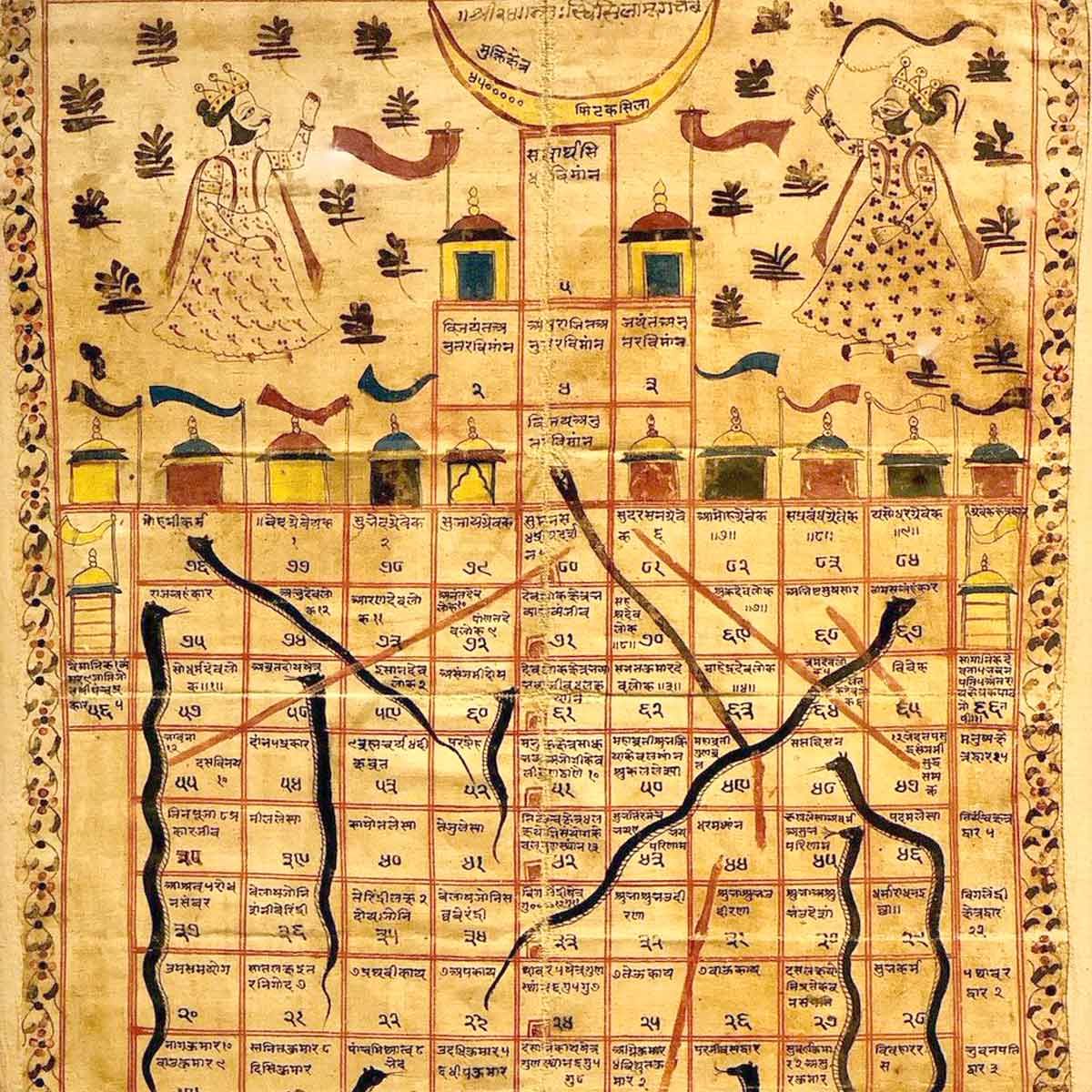More Coverage
Twitter Coverage
Satyaagrah
Written on
Satyaagrah
Written on
Satyaagrah
Written on
Satyaagrah
Written on
Satyaagrah
Written on
JOIN SATYAAGRAH SOCIAL MEDIA
"Things gained through unjust fraud are never secure": Road to Nirvana - Snakes & Ladders originated in India as Moksha Patam or Parama Padam to teach Hindu Dharma and values to children, British stole it and patented it as Snakes and Ladders

We’ve all played Snakes & Ladders as kids. It was one of our favorite board games and many afternoons with cousins and friends were spent rolling a dice to see who was first to the finish line.
|
And to be honest, it comes as no surprise that the game originated in India. But what I learned today is that the original version was nothing like how we know the game today!
The game had its origin in India and was called Moksha Patam or Parama Padam or Mokshapat. It was used to teach Hindu Dharma and Hindu values to children. The British renamed it as Snakes and Ladders.
The game was created by the 13th-century poet saint Gyandev. The ladders in the game represented virtues and the snakes indicated vices. The game was played with cowrie shells and dices. Later through time, the game underwent several modifications but the meaning is the same i.e good deeds take us to heaven and evil to a cycle of re-births. There are certain references that take the game back to the 2nd century BC.
In the original game square 12 was faith, 51 was Reliability, 57 was Generosity, 76 was Knowledge, and 78 was Asceticism. These were the squares where the ladder was found. Square 41 was for Disobedience, 44 for Arrogance, 49 for Vulgarity, 52 for Theft, 58 for Lying, 62 for Drunkenness, 69 for Debt, 84 for Anger, 92 for Greed, 95 for Pride, 73 for Murder, and 99 for Lust. These were the squares where the snake was found. The Square 100 represented Nirvana or Moksha.
Also known as ‘paramapadam’, there are a hundred squares on a board; the ladders take you up, and the snakes bring you down. The difference here is that the squares are illustrated. The top of the ladder depicts a God, or one of the various heavens (kailasa, Vaikuntha, Brahma Loka), and so on, while the bottom describes a good quality. Conversely, each snake’s head is a negative quality or an asura (demon). As the game progresses, the various karma and samskara, good deeds and bad take you up and down the board. Interspersed are plants, people, and animals.
The game serves a dual purpose: entertainment, as well as dos and don’ts, divine reward and punishment, ethical values, and morality. The final goal leads to Vaikuntha or heaven, depicted by Vishnu surrounded by his devotees, or Kailasa with Shiva, Parvati, Ganesha, and Skanda, and their devotees. In this age of moral and ethical degeneration, this would be a good way of teaching values to children who think they already know more than their parents.
If paramapadam teaches moral values, pallankuli develops skills and quick thinking. Two players compete on a board consisting of between seven and twenty pits per player; each player has to collect the coins or shells or seeds with which the game is played, the player with the maximum number being the winner. There are nine variations of this game, each a ‘pandi’, with regional, caste, and religious variations. It was very popular among women and required a good memory and alertness, as they had to count and remember the number of coins or seeds accumulated by the opponent.
The British took the game to England in 1892 and named it Snakes and Ladders and changed it according to Victorian values.
|
Equipment
The size of the grid varies but is most commonly 8×8,10×10 or 12×12 squares. Boards have snakes and ladders starting and ending on different squares; both factors affect the duration of play. Each player is represented by a distinct game piece token. A single die is rolled to determine the random movement of a player's token in the traditional form of play; two dice may be used for a shorter game.
History
Snakes and Ladders originated in India as part of a family of dice board games that included Gyan chauper and pachisi (known in English as Ludo and Parcheesi). The game made its way to England and was sold as "Snakes and Ladders", then the basic concept was introduced in the United States as Chutes and Ladders (an "improved new version of England's famous indoor sport") by game pioneer Milton Bradley in 1943.
Gyan chauper/Jnan chauper (game of wisdom), the version associated with the Jain philosophy encompassed the concepts like karma and Moksha.
|
The game was popular in ancient India with the name Moksha Patam. It was also associated with traditional Hindu philosophy contrasting karma and kama, or destiny and desire. It emphasized destiny, as opposed to games such as pachisi, which focused on life as a mixture of skill (free will) and luck. The underlying ideals of the game inspired a version introduced in Victorian England in 1892. The game has also been interpreted and used as a tool for teaching the effects of good deeds versus bad. The board was covered with symbolic images, the top featuring gods, angels, and majestic beings, while the rest of the board was covered with pictures of animals, flowers, and people. The ladders represented virtues such as generosity, faith, and humility, while the snakes represented vices such as lust, anger, murder, and theft. The morality lesson of the game was that a person can attain salvation (Moksha) through doing good, whereas by doing evil one will be reborn as a lower form of life. The number of ladders was less than the number of snakes as a reminder that a path of good is much more difficult to tread than a path of sins. Presumably, reaching the last square (number 100) represented the attainment of Moksha (spiritual liberation).
When the game was brought to England, the Indian virtues and vices were replaced by English ones in hopes of better reflecting Victorian doctrines of morality. Squares of Fulfillment, Grace, and Success were accessible by ladders of Thrift, Penitence, and Industry, and snakes of Indulgence, Disobedience, and Indolence caused one to end up in Illness, Disgrace, and Poverty. While the Indian version of the game had snakes outnumbering ladders, the English counterpart was more forgiving as it contained each in the same amount. This concept of equality signifies the cultural ideal that for every sin one commits, there exists another chance at redemption.
The association of Britain's Snakes and Ladders with India and gyan chauper began with the return of colonial families from one of Britain's most important imperial possessions, India. The décor and art of the early English boards of the 20th century reflect this relationship. By the 1940s very few pictorial references to Indian culture remained, due to the economic demands of the war and the collapse of British rule in India. Although the game's sense of morality has lasted through the game's generations, the physical allusions to religious and philosophical thought in the game as presented in Indian models appear to have all but faded. There has even been evidence of a possible Buddhist version of the game existing in India during the Pala-Sena time period.
In Andhra Pradesh, this game is popularly called Vaikunthapali or Paramapada Sopana Patam (the ladder to salvation) in Telugu. In Hindi, this game is called Saanp aur Seedhi, Saanp Seedhi, and Mokshapat. In Tamil Nadu, the game is called Parama padam and is often played by devotees of the Hindu god Vishnu during the Vaikuntha Ekadashi festival in order to stay awake during the night.
In the original game, the squares of virtue are Faith (12), Reliability (51), Generosity (57), Knowledge (76), and Asceticism (78). The squares of vice or evil are Disobedience (41), Vanity (44), Vulgarity (49), Theft (52), Lying (58), Drunkenness (62), Debt (69), Murder (73), Rage (84), Greed (92), Pride (95), and Lust (99).
|
Gameplay
Each player starts with a token on the starting square (usually the "1" grid square in the bottom left corner, or simply, off the board next to the "1" grid square). Players take turns rolling a single die to move their token by the number of squares indicated by the die roll. Tokens follow a fixed route marked on the gameboard which usually follows a boustrophedon (ox-plow) track from the bottom to the top of the playing area, passing once through every square. If, on completion of a move, a player's token lands on the lower-numbered end of a "ladder", the player moves the token up to the ladder's higher-numbered square. If the player lands on the higher-numbered square of a "snake" (or chute), the token must be moved down to the snake's lower-numbered square.
If a 6 is rolled the player, after moving, immediately rolls again for another turn; otherwise play passes to the next player in turn. The player who is first to bring their token to the last square of the track is the winner.
Variations
Variants exist where a player must roll the exact number to reach the final square. Depending on the variation, if the die roll is too large, the token either remains in place or goes off the final square and back again. (For example, if a player requiring a 3 to win rolls a 5, the token moves forward three spaces, then back two spaces.) In certain circumstances (such as a player rolling a 5 when a 1 is required to win), a player can end up further away from the final square after their move, then before it.
In the book Winning Ways, the authors propose a variant that they call Adders-and-Ladders which, unlike the original game, involves skill. Instead of tokens for each player, there is a store of indistinguishable tokens shared by all players. The illustration has five tokens (and a five-by-five board). There is no die to roll; instead, the player chooses any token and moves it into one to four spaces. Whoever moves the last token to the Home space (i.e. the last number) wins.
Specific Editions
The most widely known edition of Snakes and Ladders in the United States is Chutes and Ladders released by Milton Bradley in 1943. The playground setting replaced the snakes, which were disliked by children at the time. It is played on a 10×10 board, and players advance their pieces according to a spinner rather than a die. The theme of the board design is playground equipment, showing children climbing ladders and descending chutes.
The artwork on the board teaches morality lessons: squares on the bottom of the ladders show a child doing a good or sensible deed, at the top of the ladder there is an image of the child enjoying the reward; squares at the top of the chutes show children engaging in mischievous or foolish behavior, on the bottom of the chute the image shows the children suffering the consequences.
Black children were depicted in the Milton Bradley game for the first time in 1974. There have been many pop culture versions of the game, with graphics featuring such children's television characters as Dora the Explorer and Sesame Street. It has been marketed as "The Classic Up and Down Game for Preschoolers". In 1999, Hasbro released Chutes and Ladders for PCs.
In Canada, the game has been traditionally sold as "Snakes and Ladders" and produced by the Canada Games Company. Several Canada-specific versions have been produced over the years, including a version with toboggan runs instead of snakes.
An early British version of the game depicts the path of a young boy and girl making their way through a cartoon railroad and train system.
During the early 1990s in South Africa, Chutes and Ladders games made from cardboard were distributed on the back of egg boxes as part of a promotion.
Even though the concept of major virtues against vices and related Eastern spiritualism is not much emphasized in modern incarnations of the game, the central mechanism of Snakes and Ladders makes it an effective tool for teaching young children about various subjects. In two separate Indonesian schools, the implementation of the game as media in English lessons for fifth graders not only improved the students' vocabulary but also stimulated their interest and excitement about the learning process. Researchers from Carnegie Mellon University found that pre-schoolers from low-income backgrounds who played an hour of numerical board games like Snakes and Ladders matched the performance of their middle-class counterparts by showing improvements in counting and recognizing number shapes. An eco-inspired version of the game was also used to teach students and teachers about climate change and environmental sustainability.
|
Mathematics of the Game
Any version of Snakes and Ladders can be represented exactly as an absorbing Markov chain since from any square the odds of moving to any other square are fixed and independent of any previous game history. The Milton Bradley version of Chutes and Ladders has 100 squares, with 19 chutes and ladders. A player will need an average of 39.2 spins to move from the starting point, which is off the board, to square 100. A two-player game is expected to end in 47.76 moves with a 50.9% chance of winning for the first player. These calculations are based on a variant where throwing a six does not lead to an additional roll, and where the player must roll the exact number to reach square 100, and if they overshoot it their counter does not move.
In Popular Culture
- The phrase "back to square one" originates in the game of snakes and ladders, or at least was influenced by it – the earliest attestation of the phrase refers to the game: "Withal he has the problem of maintaining the interest of the reader who is always being sent back to square one in a sort of intellectual game of snakes and ladders."
- The game is a central metaphor of Salman Rushdie's Midnight's Children. The narrator describes the game as follows:
All games have morals; and the game of Snakes and Ladders captures, as no other activity can hope to do, the eternal truth that for every ladder you hope to climb, a snake is waiting just around the corner, and for every snake a ladder will compensate. But it's more than that; no mere carrot-and-stick affair; because implicit in the game is unchanging twoness of things, the duality of up against down, good against evil; the solid rationality of ladders balances the occult sinuosities of the serpent; in the opposition of staircase and cobra we can see, metaphorically, all conceivable oppositions, Alpha against Omega, father against mother.
- One episode of SpongeBob SquarePants, called "Sailor Mouth", features a parody of this game, known as "Eels and Escalators".
- Snakes & Lattes is a board game cafe chain headquartered in Toronto, Canada, named after Snakes and Ladders.
- In the Abby Hatcher episode, Game Time with Mo and Bo, Mo and Bo play a snakes and ladders video game on a computer tablet in a hotel. While playing they walk around, unknowingly causing trouble in the hotel. Through Abby's instructions, they use their bodies to simulate snakes and ladders to help those who are affected.
- Snakes and Ladders are referred to in the AC/DC song Sin City: "Ladders and snakes, Ladders give, Snakes take, Beggar man, thief, Ain't got a hope in hell, That's my belief".
|
References
- Coopee, Todd. "Chutes and Ladders from Milton Bradley (1943)". toytales.ca
- Althoen, S. C.; King, L.; Schilling, K. (March 1993). "How Long Is a Game of Snakes and Ladders?". The Mathematical Gazette (The Mathematical Association) 77 (478): 71–76. doi:10.2307/3619261. dx.doi.org
- Augustyn (2004), pp. 27–28
- Bornet, Philippe; Burger, Maya (2012). Religions in Play: Games, Rituals, and Virtual Worlds. Theologischer Verlag Zürich. p. 94. ISBN 9783290220105. books.google.com
- "Playing with fate and free will". Devdutt Pattanaik. September 17, 2007. devdutt.com
- Bell, R. C. (1983). "Snakes and Ladders". The Boardgame Book. Exeter Books. pp. 134–35. ISBN 0-671-06030-9.
- Masters, James. "Moksha-Patamu (Snakes and Ladders)." The Online Guide to Traditional Games. N.p., n.d. Web.
- Topsfield, Andrew (2006). The art of play. Board and card games of India. Marg Publications. ISBN 9788185026763.
- boardgamegeek.com
- Slesin, Suzanne. At 50, Still Climbing, Still Sliding New York Times 15 July 1993 nytimes.com
- "Snakes and Ladders". Elliott Avedon Museum & Archive of Games. Archived from the original on 2008-02-20. web.archive.org | gamesmuseum.uwaterloo.ca.
- Hinebaugh, Jeffrey P. (2009). A Board Game Education. R&L Education. pp. 35. ISBN 9781607092612.
- Sari, Candrika Citra, and Siti Muniroh. "Developing Snake and Ladder Game Board as a Media to Teach English Vocabulary to Elementary School Students." SKRIPSI Jurusan Sastra Inggris-Fakultas Sastra UM (2012). Web.
- Siegler, Robert S., and Geetha B. Ramani. "Playing Linear Numerical Board Games Promotes Low-income Children’s Numerical Development." Developmental Science 11.5 (2008): 655-61. Web.
- Morrison, Sarah. "Battling Climate-change: How Snakes and Ladders Could Save the Planet." The Independent, 14 Apr. 2013. Web.
- Audet, Daniel (Dec 2012). "Probabilités et espérances dans le jeu de serpents et échelles à deux joueurs". Bulletin AMQ. archimede.mat.ulaval.ca
- "Back to square one", The Phrase Finder, Gary Martin. phrases.org.uk
- Hugh-Jones, E. M. (June 1952). "The American Economy, 1860–1940. by A. J. Youngson Brown". The Economic Journal (Wiley) 62 (246): 411–414. doi:10.2307/2227038. dx.doi.org
- Rushdie, Salman (2006). Midnight's Children. Random House. p. 160. archive.org
- nytimes.com
- "Game Time with Mo and Bo". Abby Hatcher. Season 2. Episode 2. April 2020. Nick Jr.
 Support Us
Support Us
Satyagraha was born from the heart of our land, with an undying aim to unveil the true essence of Bharat. It seeks to illuminate the hidden tales of our valiant freedom fighters and the rich chronicles that haven't yet sung their complete melody in the mainstream.
While platforms like NDTV and 'The Wire' effortlessly garner funds under the banner of safeguarding democracy, we at Satyagraha walk a different path. Our strength and resonance come from you. In this journey to weave a stronger Bharat, every little contribution amplifies our voice. Let's come together, contribute as you can, and champion the true spirit of our nation.
 |  |  |
| ICICI Bank of Satyaagrah | Razorpay Bank of Satyaagrah | PayPal Bank of Satyaagrah - For International Payments |
If all above doesn't work, then try the LINK below:
Please share the article on other platforms
DISCLAIMER: The author is solely responsible for the views expressed in this article. The author carries the responsibility for citing and/or licensing of images utilized within the text. The website also frequently uses non-commercial images for representational purposes only in line with the article. We are not responsible for the authenticity of such images. If some images have a copyright issue, we request the person/entity to contact us at This email address is being protected from spambots. You need JavaScript enabled to view it. and we will take the necessary actions to resolve the issue.
Related Articles
- "The person that said winning isn’t everything, never won anything": India’s Miracle Boy Neeraj Chopra scripts history as first Indian to win silver medal at World Athletics Championships in Eugene, Oregon, best throw was 88.13 meter
- "गुनाह क्या है": Chhattisgarh national gymnasts returning from Delhi had a grim journey seated beside a dirty train toilet, a stark contrast to cricket's opulence, highlighting neglected state of many Indian sports & the urgent need for equitable support
- Proud Moment for India - Our Golden Boy turning into Diamond, Neeraj Chopra is back into action and soaring to a victory at Lausanne Diamond League 2023, smashing records with an astounding 87.66m throw, won his second title this year at Switzerland
- Bajrang Punia's Olympic hopes tumble spectacularly after a swift defeat & a ninja escape from dope test, igniting uproar over his shortcut dreams, amidst junior wrestlers' loud calls for fairness & a shot at glory through hard-earned, sweat-soaked trials
- "The harder the battle, the sweeter the victory": Unprecedented Triumph: Indian Badminton Duo Satwiksairaj Rankireddy and Chirag Shetty etched their names in history by clinching men's doubles title at the prestigious Indonesia Open with Super 1000 Win
- “Show up, show up, show up, and after a while the muse shows up, too”: From bamboo sticks to World Cup debut, inspiring story of Indian hockey team's Nilam Sanjeep Xess who is set to make his debut in the upcoming FIH World Cup 2023
- ‘I lost to a transgender in Asian Games, I want my medal back’: In a twist of fate at the Asian Games, defending champion Swapna Barman voices controversy, claiming her loss to Telangana's rising star Nandini Agasara was more than just a battle of skill
- "People who values its privileges above its principles soon loses both": U20 World Championship winner Antim Panghal moves court to challenge Vinesh Phogat’s direct selection to Asian Games, Vishal Kaliraman also opposes free pass to Bajrang Punia
- "Follow your inner moonlight; don’t hide the madness”: Rajasthan girl makes India proud, State’s first female body-builder Priya Singh wins gold at International Body-Building Championships, mother of two maintains a balance between home and the gym
- "Sometimes a legend that endures for centuries...endures for a reason": Greatest of all time, three-time World Cup-winning Brazilian football legend Pele passes away at the Albert Einstein Hospital in Sao Paulo, was diagnosed in 2021 with colon cancer
- India shatters records at the Asian Games 2023, hitting an unprecedented 100-medal milestone, Celebrations echo nationwide, as PM Modi and champion athletes Jyothi Surekha Vennam and Ojas Deotale share their pride and joy in this remarkable feat
- "Winning takes precedence over all. There's no gray area. No almosts": Wrestler Vinesh Phogat defeated Sri Lanka’s Chamodya Keshani Maduravlage Don to create history, becomes the first Indian woman to win Gold at CWG and Asian Games
- Making history as the first-ever Indian to win Gold at World Athletics Championships, Neeraj Chopra's javelin blazed through Budapest's skies, marking an unparalleled epoch at global stage and inspiring a new era of champions to emerge and conquer
- "साथी हाथ बढ़ाना": Indian government steps in with 40 ACs for athletes battling Paris's scorching heat at the Olympics, while Arjun Babuta criticizes Punjab's AAP government for failing to support sports, highlighting unmet promises and neglect
- "It was horrible.. cheating shouldn't be appreciated": False start, threat of disqualification, trauma, protests and a medal upgrade, this is what all hurdles Jyothi Yarraji had to cross before claiming silver in 100m hurdles after false start by Yanni Wu




























